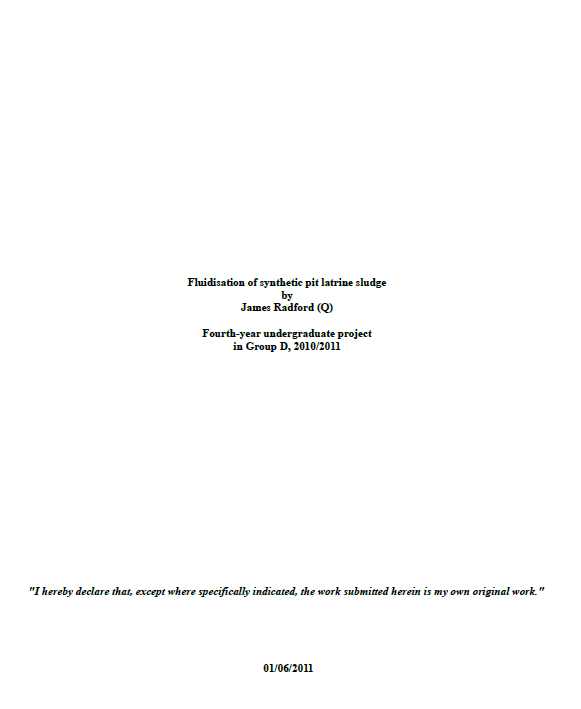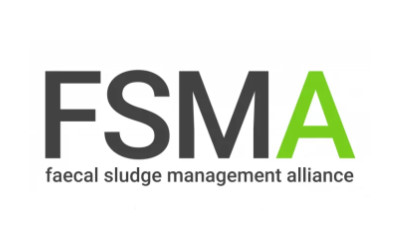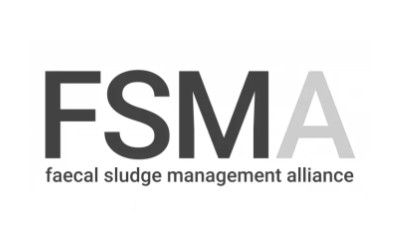
Published in: 2011
Publisher:
Fourth-year undergraduate project in Group D, 2010/2011, University of Cambridge, UK
Author:
Radford, J.
Uploaded by:
SuSanA secretariat
Partner profile:
common upload
4039 Views
39 Downloads
Content - Summary
The first phase of the investigation involved the development of the synthetic sludge and a process for its physical characterisation. Reference data on the physical characteristics of pit latrine sludge were obtained from a study done by the International Reference Centre for Waste Disposal in Botswana during the 1980s. A synthetic sludge consisting of clay and compost was developed to replicate these characteristics. Undrained shear strength and density were identified as the critical parameters controlling 'pumpability'.
It was found that for a given solid composition of sludge, water content correlates strongly with undrained shear strength, and by varying its water content the full range of reported sludge shear strengths could be achieved. The density of the synthetic sludge was found to be significantly lower than that reported by the IRCWD, with a difference in means of around 300kg/m3. This is due to the low density of the organic matter in compost, and claystabilised soil has been proposed as a possible alternative synthetic sludge with higher density. It was not possible to determine the effect of solid composition on sludge flow behaviour due to difficulty in controlling water content when different solid compositions were used. The variability in water content of the compost used in the sludge also prevented the development of an absolute 'recipe' for different strengths of sludge and certain amount of experimentation will therefore always be required when developing synthetic sludge from locally available materials. Nevertheless, the synthetic sludge mixture was deemed suitable to investigate the effect of fluidisation. The reduction in sludge shear strength from fluidisation was found to be caused by two effects – dilution, which increases water content, and remoulding, which involves mechanical agitation to break down the structure of the material. A one-fifth scale pit emptying device, powered by two modified vacuum cleaners, was used to carry out the fluidisation tests.
The first series of tests was done on a uniform sludge and demonstrated that fluidisation by dilution alone was feasible, however a 23% increase in water content was required to make a strong sludge 'pumpable'. Samples were then left to consolidate before being characterised, producing a material more representative of that found in a pit latrine. Injecting air into these samples produced a three-fold decrease in strength as a result of remoulding at constant water content. The large increase in water content during fluidisation by dilution causes a large increase in volume which would probably be impractical as there would be insufficient space in the pit. One solution could be to suck weak supernatant off the top of the pit for fluidisation, thereby eliminating the volume increase, however this has associated health risks as the supernatant is heavily contaminated with pathogens. Fortunately this may not be necessary in many cases as air-blown remoulding alone would be sufficient to fluidise all but the strongest of sludges.
The implications for sludge treatment and disposal have been discussed, with the increase in volume and solids content of the sludge removable from the pit potentially encouraging illegal dumping if not managed carefully. It has also been proposed that sludges should be classified according to the equipment required to remove them from the latrine, and possible field tests have been suggested to estimate sludge density and shear strength. The performance of the equipment used in the laboratory greatly exceeded expectations. This serves as a proof of concept that cheap and easily replaceable vacuum cleaners could be used to replace the expensive vane pumps currently used in most suction-based pit emptying technologies.
Finally, various suggestions have been made for further work, including the development of a synthetic sludge that is more representative of pit latrine sludge and fullscale fluidisation trials using both synthetic and actual pit latrine sludge to validate the findings of this investigation.
Bibliographic information
Radford, J. (2011). Fluidisation of synthetic pit latrine sludge. Fourth-year undergraduate project in Group D, 2010/2011, University of Cambridge, UK
Filter tags
English Europe & Central Asia Faecal sludge treatment processes















